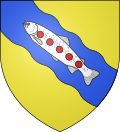Fislis | |
|---|---|
 A general view of Fislis | |
| Coordinates: 47°30′19″N7°22′57″E / 47.5053°N 7.3825°E | |
| Country | France |
| Region | Grand Est |
| Department | Haut-Rhin |
| Arrondissement | Altkirch |
| Canton | Altkirch |
| Government | |
| • Mayor (2020–2026) | Clément Libis [1] |
Area 1 | 7.53 km2 (2.91 sq mi) |
| Population (2022) [2] | 387 |
| • Density | 51/km2 (130/sq mi) |
| Time zone | UTC+01:00 (CET) |
| • Summer (DST) | UTC+02:00 (CEST) |
| INSEE/Postal code | 68092 /68480 |
| Elevation | 377–532 m (1,237–1,745 ft) (avg. 385 m or 1,263 ft) |
| 1 French Land Register data, which excludes lakes, ponds, glaciers > 1 km2 (0.386 sq mi or 247 acres) and river estuaries. | |
Fislis (French pronunciation: [fislis] ) is a commune in the Haut-Rhin department in Alsace in north-eastern France.



